The 4 Functions of Management: What Managers Need to Know
Learn the 4 functions of management, including planning, organizing, leading, and controlling, with practical tips and examples.
Management is the backbone of any successful organization. Whether you’re leading a small team or overseeing an entire company, understanding the core functions of management is essential for driving results. The four functions of management - planning, organizing, leading, and controlling - provide a framework that helps managers navigate challenges, align teams, and achieve goals. This article breaks down each function, offering practical insights and actionable strategies to help managers apply these principles effectively.
What Are the 4 Functions of Management?
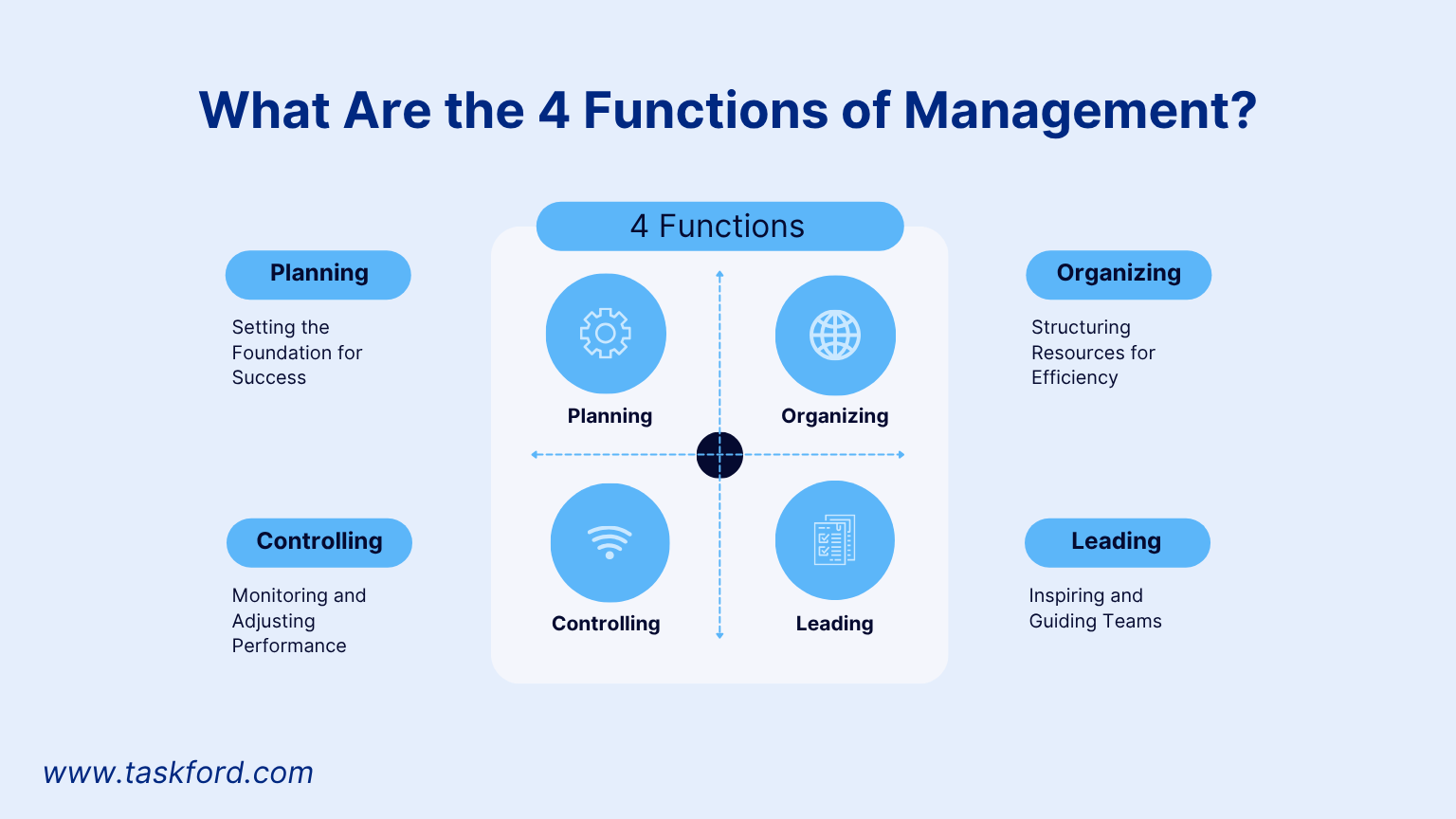
The four functions of management, first outlined by Henri Fayol in the early 20th century, are a time-tested approach to structuring managerial work. These functions - planning, organizing, leading, and controlling - work together to ensure organizations operate efficiently and meet their objectives. By mastering these functions, managers can improve team performance, foster collaboration, and adapt to changing environments.
This guide explores each function in detail, providing practical tips and real-world examples to help managers at all levels succeed. Whether you’re a new manager or looking to refine your skills, understanding these functions will equip you to handle the complexities of leadership.
Why the 4 Functions Matter
The four functions of management are not just theoretical concepts; they are practical tools that help managers:
- Set clear goals and strategies.
- Allocate resources effectively.
- Motivate and guide teams.
- Monitor progress and make adjustments.
By applying these functions, managers can create a structured approach to leadership, ensuring their teams stay focused and productive. Let’s dive into each function and explore how to put them into practice.
1. Planning: Setting the Foundation for Success
Planning is the first and arguably most critical function of management. It involves defining goals, determining the best course of action, and developing strategies to achieve those objectives. Effective planning provides direction, reduces uncertainty, and helps teams stay aligned with organizational priorities.
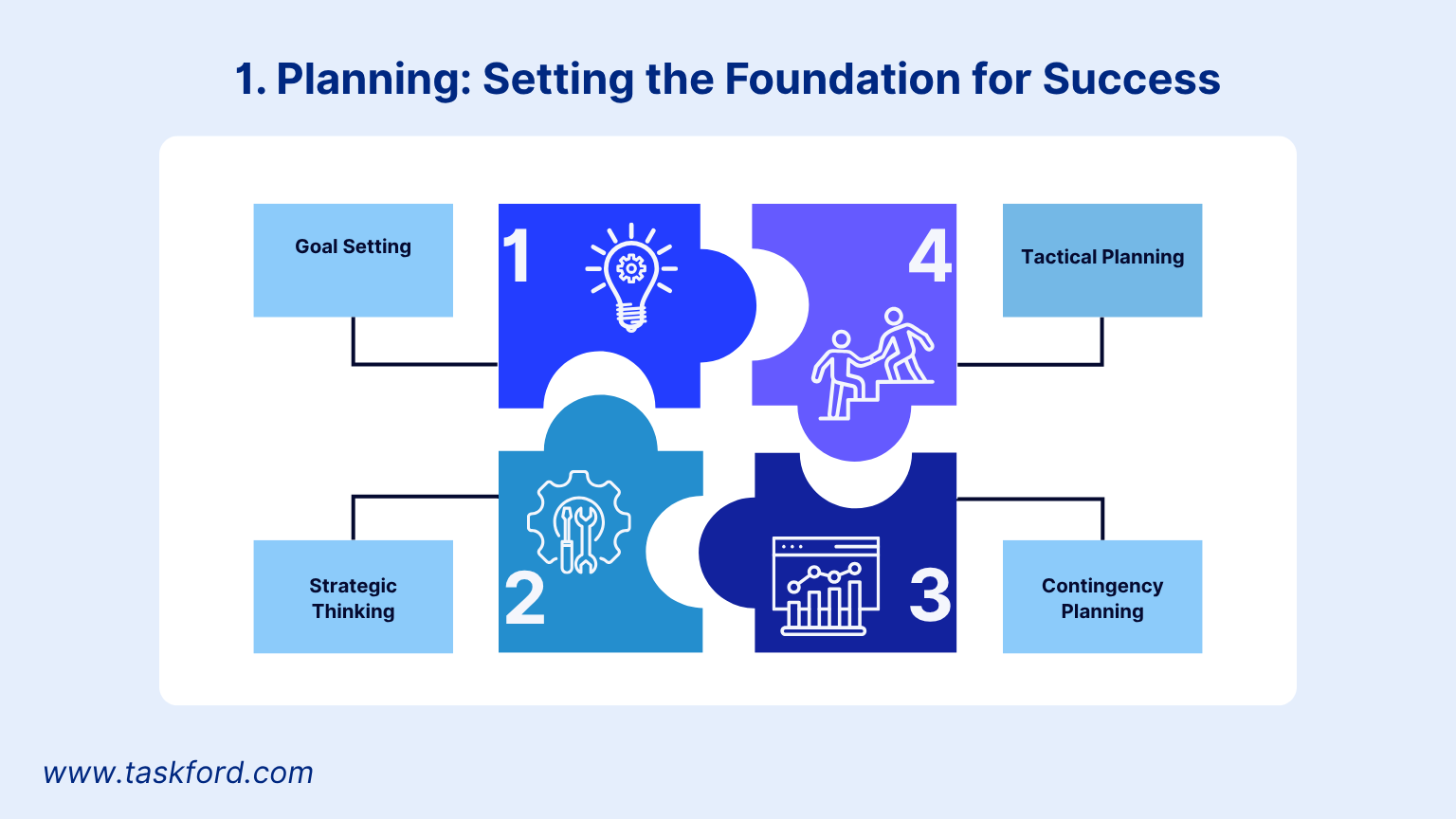
Key Elements of Planning
- Goal Setting: Establish clear, measurable objectives. For example, a sales team might aim to increase revenue by 10% within six months.
- Strategic Thinking: Develop long-term plans that align with the organization’s mission. This could involve expanding into new markets or launching a new product.
- Tactical Planning: Break down long-term goals into short-term, actionable steps. For instance, a marketing manager might plan a monthly campaign to boost brand awareness.
- Contingency Planning: Prepare for unexpected challenges, such as supply chain disruptions or economic shifts, by creating backup plans.
Practical Tips for Effective Planning
- Use SMART Goals: Ensure goals are Specific, Measurable, Achievable, Relevant, and Time-bound. For example, instead of “improve customer satisfaction,” aim to “increase customer satisfaction scores by 15% in Q3.”
- Involve Your Team: Engage team members in the planning process to gain diverse perspectives and build buy-in. Learn more about team collaboration strategies here.
- Leverage Data: Use market research, performance metrics, or customer feedback to inform your plans. Tools like SWOT analysis (Strengths, Weaknesses, Opportunities, Threats) can help identify key factors.
- Review Regularly: Revisit plans quarterly or annually to ensure they remain relevant and adjust as needed.
Example of Planning in Action
Imagine a retail manager tasked with increasing store sales. They might start by analyzing sales data to identify trends, then set a goal to boost foot traffic by 20% in three months. Their plan could include hosting in-store events, partnering with local businesses, and launching a targeted social media campaign. By anticipating challenges, like staffing shortages, they might also train additional part-time staff as a contingency.
2. Organizing: Structuring Resources for Efficiency
Organizing is the process of arranging resources - people, materials, and systems - to execute the plan. This function ensures that the right people are in the right roles, tasks are clearly defined, and resources are allocated effectively.
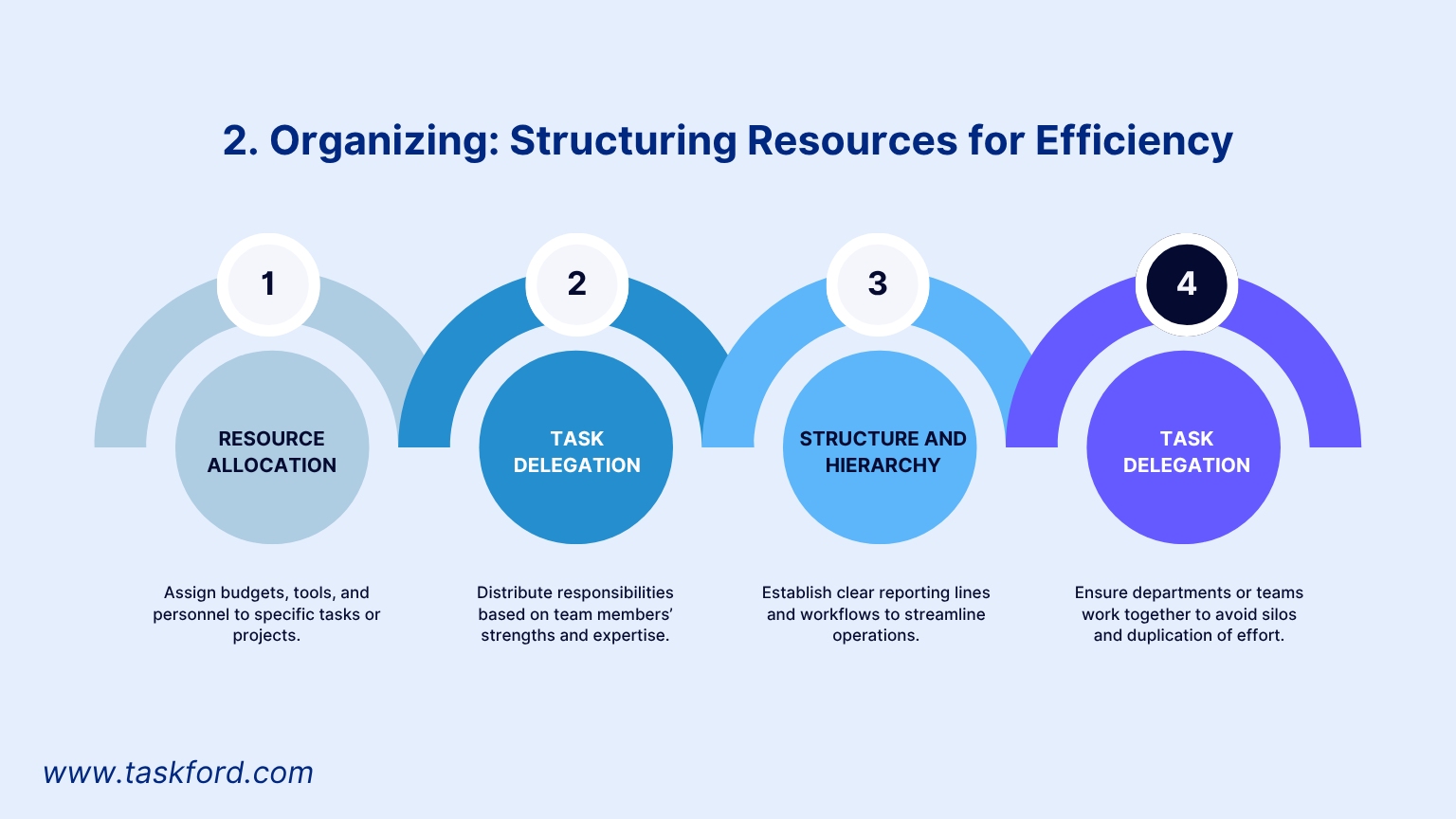
Key Elements of Organizing
- Resource Allocation: Assign budgets, tools, and personnel to specific tasks or projects.
- Task Delegation: Distribute responsibilities based on team members’ strengths and expertise.
- Structure and Hierarchy: Establish clear reporting lines and workflows to streamline operations.
- Coordination: Ensure departments or teams work together to avoid silos and duplication of effort.
Practical Tips for Effective Organizing
- Create Clear Job Roles: Define responsibilities and expectations for each team member to avoid confusion. For example, a project manager might assign specific deliverables to team members with clear deadlines.
- Use Organizational Tools: Project Management Tools (e.g., TaskFord) with built-in Resource Management can help track tasks, deadlines, and organize resources effectively.
- Match Skills to Tasks: Assign tasks based on employees’ strengths. For instance, a detail-oriented team member might handle data analysis, while a creative employee leads brainstorming sessions.
- Streamline Processes: Regularly review workflows to eliminate inefficiencies, such as redundant approvals or outdated procedures.
Example of Organizing in Action
Consider a manager overseeing a product launch. They organize their team by assigning roles: a marketing specialist develops the campaign, a logistics coordinator manages inventory, and a sales lead trains the team on product features. They use a shared project management tool to track progress and hold weekly check-ins to ensure alignment. By clearly defining roles and resources, the manager ensures the launch runs smoothly.
3. Leading: Inspiring and Guiding Teams
Leading, sometimes called directing, involves motivating and guiding employees to achieve organizational goals. This function focuses on communication, motivation, and fostering a positive work environment. Effective leadership builds trust, encourages collaboration, and drives performance.
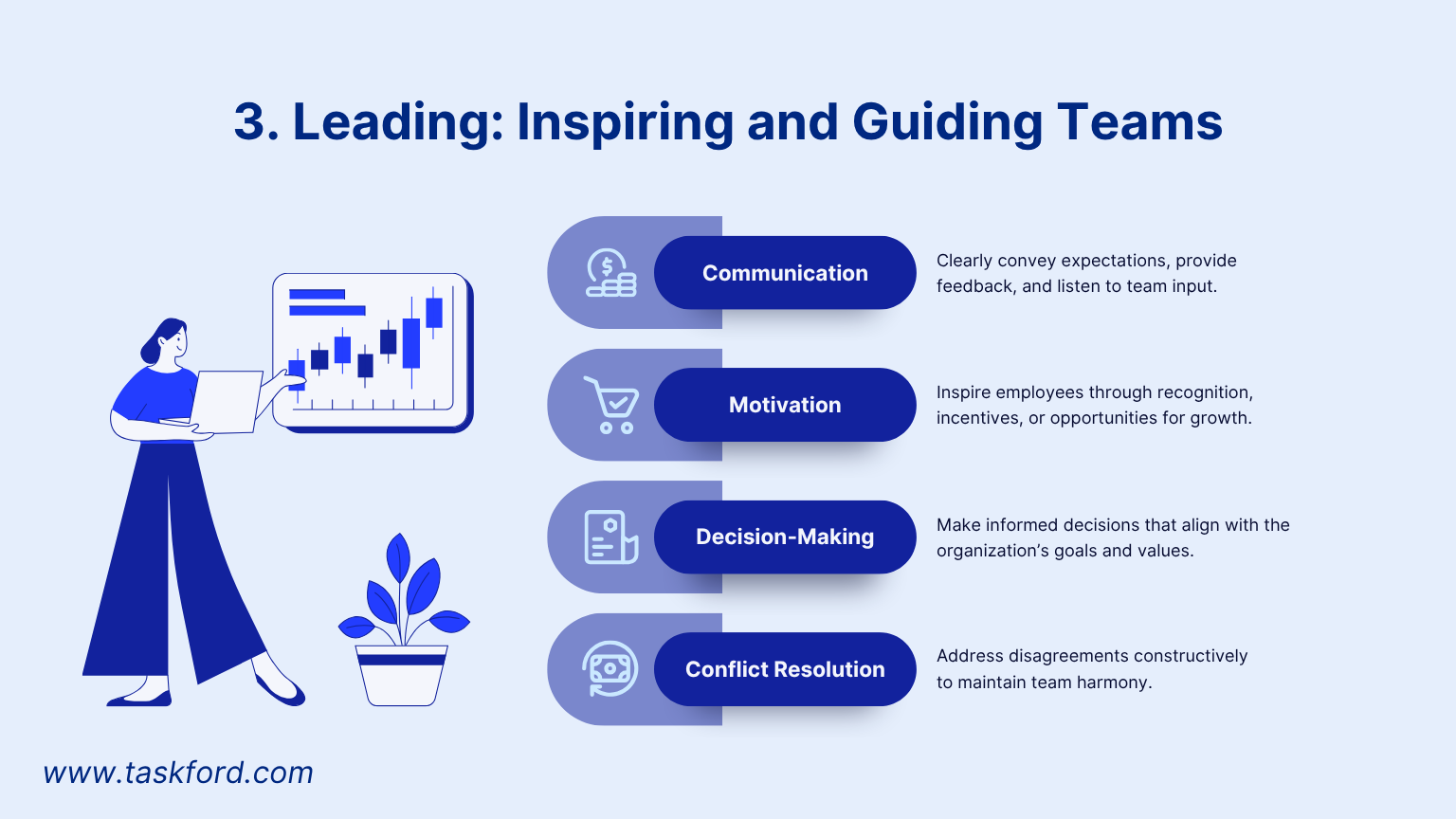
Key Elements of Leading
- Communication: Clearly convey expectations, provide feedback, and listen to team input.
- Motivation: Inspire employees through recognition, incentives, or opportunities for growth.
- Decision-Making: Make informed decisions that align with the organization’s goals and values.
- Conflict Resolution: Address disagreements constructively to maintain team harmony.
Practical Tips for Effective Leading
- Practice Active Listening: Show employees their input is valued by summarizing their points and asking clarifying questions.
- Set a Positive Example: Demonstrate the work ethic and attitude you expect from your team. For example, arrive on time and meet deadlines consistently.
- Provide Feedback: Offer constructive feedback regularly, balancing praise with areas for improvement. Learn how to give effective feedback here.
- Adapt Your Leadership Style: Tailor your approach to individual team members. Some may respond to hands-on guidance, while others prefer autonomy.
Example of Leading in Action
A team leader notices declining morale during a busy quarter. To address this, they hold one-on-one meetings to understand employee concerns, then implement a recognition program to celebrate small wins. They also organize a team-building activity to strengthen relationships. By addressing concerns and fostering a positive environment, the leader boosts productivity and engagement.
4. Controlling: Monitoring and Adjusting Performance
Controlling is the process of monitoring performance, comparing it to goals, and making adjustments as needed. This function ensures that the organization stays on track and addresses issues before they escalate.
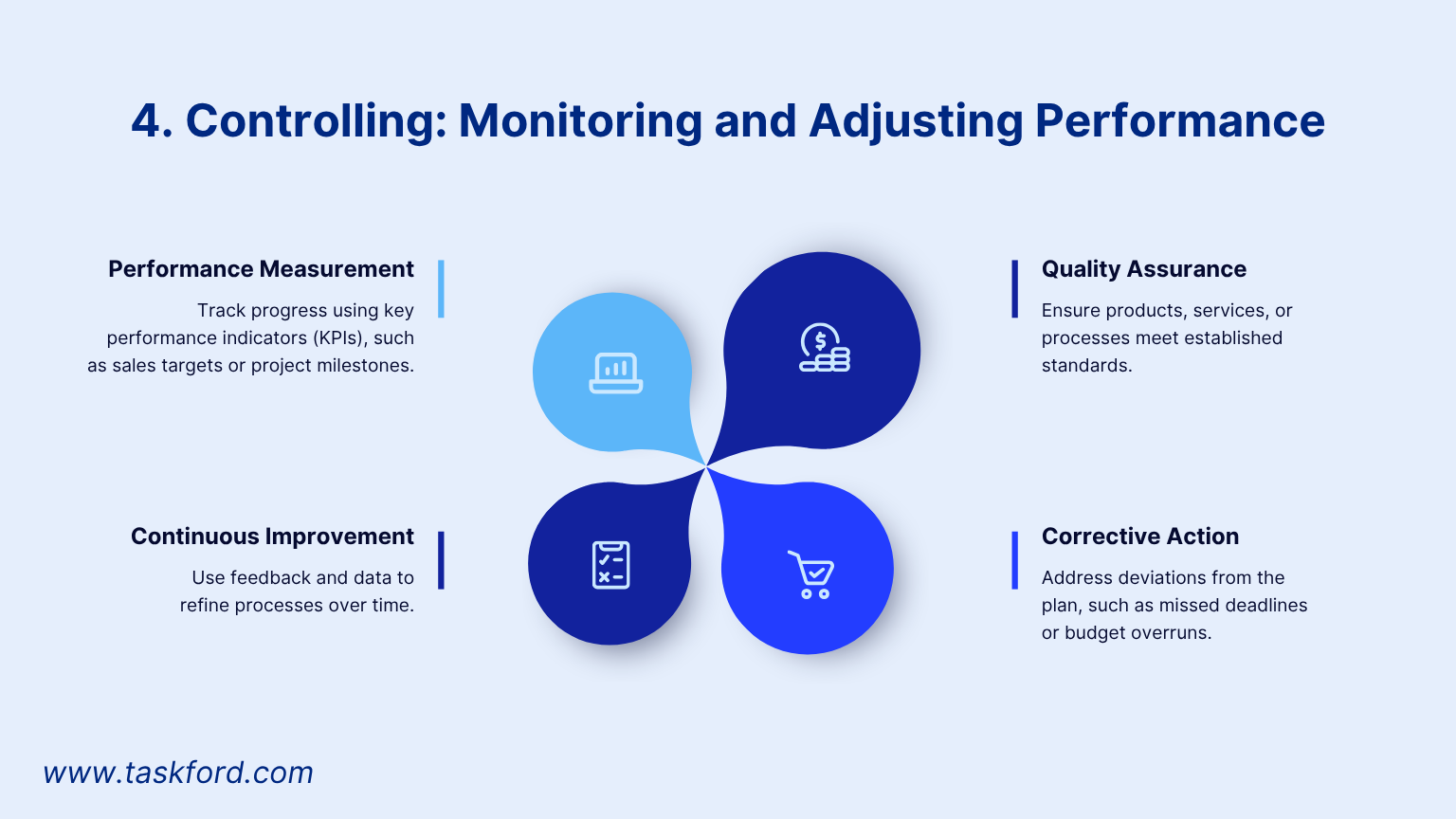
Key Elements of Controlling
- Performance Measurement: Track progress using key performance indicators (KPIs), such as sales targets or project milestones.
- Quality Assurance: Ensure products, services, or processes meet established standards.
- Corrective Action: Address deviations from the plan, such as missed deadlines or budget overruns.
- Continuous Improvement: Use feedback and data to refine processes over time.
Practical Tips for Effective Controlling
- Set Clear KPIs: Define measurable metrics, such as customer retention rates or production output, to track progress.
- Use Technology: Implement dashboards or analytics tools to monitor performance in real time.
- Conduct Regular Reviews: Hold weekly or monthly meetings to assess progress and address issues. Discover performance management strategies here.
- Encourage Accountability: Empower employees to take ownership of their work and report on their progress.
Example of Controlling in Action
A manufacturing manager tracks production output using a dashboard that monitors units produced per hour. When output falls below the target, they investigate and discover a machine malfunction. They arrange for repairs and adjust the production schedule to meet deadlines. By monitoring performance and acting quickly, the manager minimizes disruptions.
How the 4 Functions Work Together
The four functions of management are interconnected, creating a cycle that drives organizational success. Planning sets the direction, organizing aligns resources, leading motivates the team, and controlling ensures progress stays on course. For example, a manager planning a new product launch will organize resources, lead the team through execution, and monitor performance to ensure the launch meets its goals.
Common Challenges and Solutions
- Unclear Goals: If planning lacks clarity, teams may lose focus. Solution: Use SMART goals and communicate them clearly.
- Poor Resource Allocation: Disorganized resources can lead to delays. Solution: Conduct regular resource audits to ensure alignment with priorities.
- Lack of Motivation: Without strong leadership, teams may disengage. Solution: Foster open communication and recognize achievements.
- Ineffective Monitoring: Failing to track progress can derail plans. Solution: Implement regular check-ins and use data-driven tools.
Applying the 4 Functions in Modern Management
Today’s managers face unique challenges, such as remote work, rapid technological changes, and diverse teams. The four functions remain relevant but require adaptation:
- Planning for Flexibility: Build adaptability into plans to accommodate unexpected changes, like shifts in market demand.
- Organizing Remote Teams: Use digital tools to coordinate tasks and maintain clear communication across locations.
- Leading with Empathy: Prioritize employee well-being and inclusivity to build trust in diverse or remote teams.
- Controlling with Technology: Leverage data analytics and automation to monitor performance efficiently.
Conclusion
The four functions of management - planning, organizing, leading, and controlling - are essential tools for any manager aiming to achieve organizational goals. By setting clear plans, structuring resources effectively, inspiring teams, and monitoring progress, managers can navigate challenges and drive success. Whether you’re managing a small project or a large organization, mastering these functions will help you lead with confidence and deliver results.
Subscribe for Expert Tips
Unlock expert insights and stay ahead with TaskFord. Sign up now to receive valuable tips, strategies, and updates directly in your inbox.